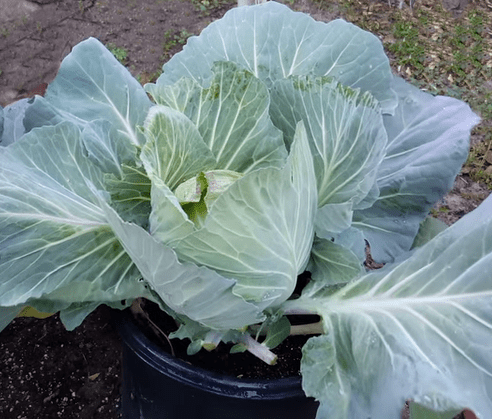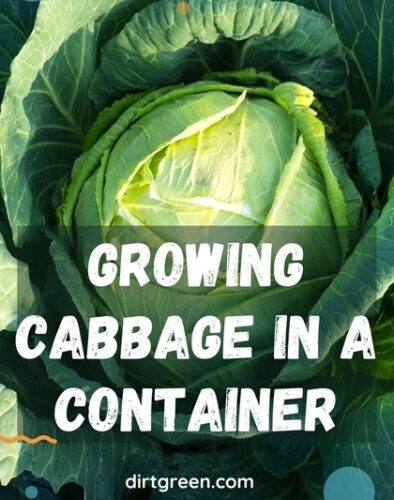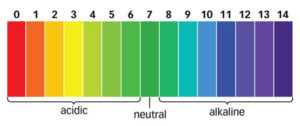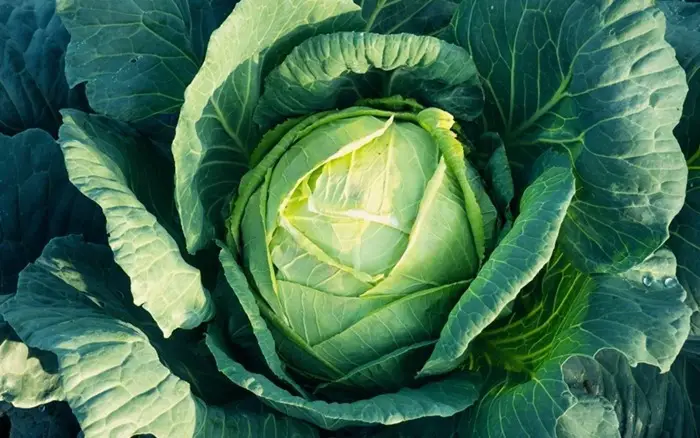A lot of people often ask questions like, Is growing cabbage in a container possible if you don’t have a backyard garden?
Well, the answer is yes. It is quite possible to grow cabbage in a container.
So, in this post, we are going to provide basic instructions on how to successfully grow cabbage in a container.
Not everyone will have a backyard garden; however, gardening in containers is a trend in many households.
Even people with backyard gardens still use containers for certain plants that need special care.
So, when it comes down to growing cabbages in containers, they are no different than when they are planted in the ground or in raised beds.
However, when it comes down to cabbages growing in containers, the size of the cabbage may be a bit smaller than when it’s planted in the ground.
Nonetheless, let’s have a look at some basic things you can do to get started with your container garbage.

The Ideal Container Size to Grow Cabbage in
The ideal size of a container to grow a cabbage in is a 17 by 17 container, which is a standard 17-inch height and a 17-inch wide container.
However, it is not limited to this size; any container wider than 17 inches with good height or a 7-gallon bucket will do well for one cabbage plant as well.
Cabbage normally grows well in containers where there are lots of plants that spread out without interference or competition.
Related Read: Alternate Versions of Fruits

How to Sow Cabbage Seeds for Containers?
Cabbage can be sown in the soil or the container you want to plant it in; however, it is best to sow your cabbage seeds indoors in a planting tray 6 weeks before transplanting.
If you are living in areas where the weather is mostly warm, it’s best to start growing cabbage in early spring or early fall.
Cabbage is mostly a cool-season plant and does very well in cold temperatures.
Sow your cabbage seeds at least half an inch (6mm) deep in your starter mix. Keep the starting kit of mixed compost moist at all times.
Once the cabbage seed has germinated and reaches at least 4 inches in height, it can be planted in containers or raised beds.
So, by doing that, it will give your cabbages a great head start while you monitor and watch them grow healthy and strong.
Types Of Potting Mix For Container Cabbage
There are many different combinations of potting mix you can use for growing cabbage in a container. If you are using pure compost it may not be enough to support the cabbage plant.
Some base potting mixtures to use are chicken or goat manure along with organic fertilizer and a vermiculite mixer.
So, since the cabbage plant is a cool-temperature plant, the vermiculite mixture will help the cabbage stay cool on hot days.
If you are wondering what the quantity should be,?
Well, it all depends on the size container you are using. For the best results, use half of each potting mix and less fertilizer.
For example: In total, 100%
- Regular Compost = 30%
- Chicken Manure = 30%
- Vermiculite Mixture (Others) = 30%
- Fertilizer = 10 %
Nevertheless, even though cabbages are cool plants, they need up to 6 hours of sunlight per day. When it comes to water, if you have pure sunlight during the day, you sure need water daily.
If the temperature is between 65 and 75 degrees Fahrenheit during the day, watering 2-3 times per week should be enough for your cabbage plant.

Red Acer Cabbage
The Best Type Of Cabbage to Grow In a Container
The best types of cabbages that will grow well in containers are red acer cabbages, savoy cabbages, giant cabbages, and traditional cabbages.
Red Acer Cabbage:
The Red Acer Cabbage is a great choice to plant in containers and a raised bed garden. Red cabbages have five times more nutritional value than most cabbages.
Savoy Cabbage:
The Savoy Cabbage is a unique bag that looks and tastes different from your regular traditional bags.
Savoy Cabbage has stylish curly green leaves that form the bag. Its unique taste and look make it a great choice to plant in containers.
Gaint Cabbage:
When it comes to the giant variety of cabbage, they tend to feed on a lot of water as fertilizer. However, once they have been successfully grown, they will produce a large head of cabbage. Its taste is much different than that of the Savoy, Red Acer, and traditional Cabbage.
What Type Of Fertilizers To Use On Container Cabbage
Cabbage is a leafy green vegetable plant that relies on high-compound fertilizers.
Some compost already has fertilizer in it; however, if you are planting in raised beds or a container, there are three types of fertilizer to use.
Types of Fertilizers
- All-Purpose Fertilizer
- Compost Tea Fertilizer
- Seaweed Emulsion Fertilizer
It is ideal to mix organic matter with the soil in which you plant the cabbage; this will help the cabbage grow and survive at a much higher rate.
Why?
Well, since cabbages, or mostly leaves, need a lot of nutrients to grow healthy and fruitful,.
If you are using liquid fertilizers, apply them once per month to the cabbage container plant.
Also, if you are using soil fertilizers, you can sprinkle them around the cabbage plant at least twice per month.
Container Cabbage Growth Quality
If you notice that your garbage or cabbage looks poor in growth, there are two things you need to check to fix that issue.
Nutrition Level:
Make sure that your cabbage plant is getting enough nutrition as well as lots of sunlight and water.
These are the two major things to check if your garbage growth is poor.
Soil pH:
Cabbage soil pH is typically 6.5 when using a pH tester for the soil. If you have anything less than that, your soil pH might not be enough for your leafy green cabbage.

Insects That Affect Cabbage Plants
There are several different types of insects that love to feed on cabbage leaves. To name a few, there are aphids, cabage loopers, and slugs.
How to Remove Cabbage insects
Aphids:
Aphids are small, ant-looking insects that pill up together under the leaves of the cabbage. To get rid of them, all you need to do is wash them off with soapy water or a power hose.
Cabbage Loopers:
Cabbage loopers are small green worms that feed on the cabbage leaf when the butterfly lays its eggs on the plant. To get rid of looper worms, monitor, handpick, or use organic pesticides to remove them.
Slugs:
Slugs are slimy-looking worms that can do a lot of harm to your cabbage plant by making huge holes in the leaves or devouring most of the leaves as a whole.
They are handpicked at night, but it’s ideal to use products such as slug baits to stop them in their tracks.
How long does garbage take to harvest?
Cabbages that are planted without transplanting take approximately 4–6 months to harvest, which is equal to 90–180 days.
Transplanted cabbages can take up to 3–4 months to harvest, depending on the variety of cabbage.
So all in all, caggabges can grow pretty well in containers and raised beds if they get the care and nutrients they need to survive.
Growing cabbage in a container is sometimes the reason why most farmers prefer to harvest cabbage because of pests and insects.
This way, they can alleviate the use of chemicals on the leafy green vegetable cabbage that can be harmful to your health.
Related Read: Can Peas Grow in a Container?




